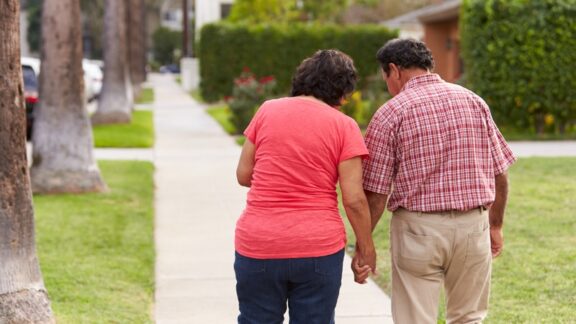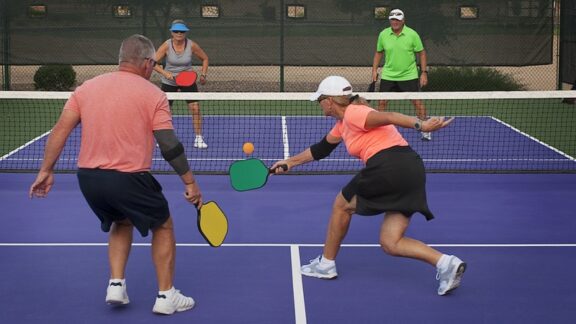It’s just like riding a bike. Or is it? Seniors Guide writer Terri L. Jones has recently begun cycling again and has learned that much is different from when she rode as a child. She spoke with seasoned cyclists for tips on riding a bike in the 21st century, including factors important to an older adult.
My husband and I recently moved to southern Delaware, where there are more than 100 miles of trails and countless cyclists crowding these narrow byways almost every single day of the year. Whether riding to get from here to there or whizzing down the trails for exercise or sport, biking is part of the lifestyle here, as it is in so many communities these days.
Tips for riding a bike again
Like us, you may be contemplating dusting off your bike and climbing back in the saddle again; however, riding a bike these days isn’t quite the same as riding when you were 12. In other words, taking up cycling again is not necessarily “like riding a bike.”
That’s why we asked several avid cyclists for their best advice in getting restarted. Here’s what they told us:
1. Start with the right bike
First, choose your type of bike based on where and how often you’ll be riding it and what you hope to get out of your bike, like a comfortable ride, speed, bike races, etc. Here’s a good explanation of the 11 types of bikes and how to choose the one that is right for you, including electric.
Related: A Seniors Guide overview of electric bikes
Because the right size bike can prevent injury and improve your ride, Carolee, who rides 20 to 30 miles a week with her wife, Shannon, recommends getting a professional bike fitting. “It’s well worth the investment!” she says.
Type and size of bike aren’t your only considerations when choosing a bike. You also need to choose the position of the crossbar (or the metal bar that runs from the handlebars to the bike’s seat). Traditionally, men’s bikes have had a high, horizontal crossbar with the crossbar on women’s bikes being low and slanted to allow women (when they only wore skirts and dresses) to modestly get on and off the bike. However, this ease in mounting makes bikes with a low crossbar – or what’s now known as a “step-through” frame – great for other people, like delivery drivers and people with short legs, balance issues or limited range of motion, too. My husband, Don, who has had several joint replacements, decided that a step-through bike offered him more stability when stopping and starting, and therefore, increased his confidence on rides.
2. Sitting comfortably

A well-fitted and adjusted seat (or “saddle,” in cycling parlance) can be the difference between a pleasurable and a painful ride. “Consider working with a professional bike store to get some feedback on the best type for your style of bike as well as some guidance on fitting the saddle to your rear end,” advises Shannon, who found cycling the ideal way to keep her mental health in check during the COVID lockdown.
“Lots of folks ride with their seat too low, which results in knee pain. …” explains Bob, who has taken many cycling vacations with his wife, Ruth. “The rule of thumb is that when you’re sitting on your seat you should just be able to touch the ground with your tiptoes. Another way is to sit on the seat and put your foot on the pedal in the down position. Your leg should be 95 percent extended.”
3. The right stuff
All the cyclists we talked to recommended carrying an extra tire tube with you, along with tire levers and a pump. Bob says, “There are many friendly cyclists out there who will be happy to assist you with a flat, but you need to have the right equipment with you.”
For visibility to other riders or drivers, Shannon suggests purchasing some rechargeable bike lights for the back and front of your bike. Plus, a bike bell lets you announce yourself when passing. You can also call out “on your left,” but be sure to yell it loudly, as the person up ahead could have earbuds in!
That’s all to ensure other riders see you, but how do you make sure you see them? A bike mirror that attaches to your handlebars allows you to keep an eye on bikes or cars approaching from behind.
Related: 10 fitness tips for easing back into exercise
4. The rules of the road
You should always stay to the right of the road or trail and obey all traffic laws when you are riding on the road. Roseanne, who is headed on a biking trip in Croatia, stresses that you should always understand the rules of the road wherever you’re riding to remain safe.
Use hand signals to alert people of your movements: left arm fully extended for a left turn, right arm fully extended or left arm bent up at a right-angle for a right turn and left arm bent down at a right angle for stopping or slowing. And be sure to signal well in advance of the action you’re taking.
Pat, who enjoys riding with friends, cautions that you can’t always ride side by side with your cycling companions. Often, you’ll need to cycle single file to allow room for oncoming bike traffic, passing riders and cars in an adjacent lane.
5. Clothes make the cyclist
The most important piece of cycling apparel is your helmet. “I know it messes with your hair,” laughs Bob. “So what? You’d rather have messy hair than a messy head if you are in an accident.”
Pat was glad she had a helmet on the day she fell off her bike on a flat trail. “Luckily I just got the wind knocked out of me by a handlebar, but I easily could have hit the fence.”
We also heard from most of the cyclists that padded bike shorts are imperative. “These shorts look like a normal short, not too tight or short,” explains Ruth. Adds her husband, Bob, “For those who haven’t ridden in a while, the bum is what is going to hurt the most, especially the second day you saddle up.”
Shannon agrees, “Your butt will thank you!”
And those neon-colored shirts and jackets that you see many cyclists wearing aren’t just an attempt to look like they’re competing in the Tour de France! Those bright colors make them visible to other cyclists and drivers.
Lastly, bike gloves will cushion your hands and arms, particularly on bumpy terrain. If the vibration of the handlebars makes you itchy (as it does me), bike gloves can provide a buffer.
6. Final pro tips
If you grew up riding a bike without gears, Carolee advises taking some time to learn how to properly use your gears: “Gears help you keep maximum efficiency while pedaling, no matter where you are riding.”
While gears can take some of the burden off your legs, you’ll still need to build endurance for your bike rides. The best way to work up to longer, more strenuous rides is to increase your distance by two to five miles each time you take your bike out, says Shannon, whose rides are typically no shorter than 20 miles. What’s more, she suggests, “Adding in other types of exercise, such as weightlifting and core work, can help with improving leg strength and overall strength on the bike.”
If you have concerns about your stamina – especially as you get started – or you live in an area with lots of hills, consider a power-assist electric bike. You can peddle when you want and let the electric motor do the work the rest of the time.
It’s important to stay hydrated as you cover all those miles. “My rule of thumb is to try and drink one bottle of water per 10 miles,” recommends Shannon, who has two water bottle holders on her bike. On longer rides, Bob suggests investing in a hydration backpack (with an extended tube), which keeps you from having to reach for your water bottle while riding.
But before you hop on your bike and take off for a ride, Roseanne advises: “Always check the air in your tires and test your brakes (especially if you removed the front tire to transport your bike).”
Happy cycling!





